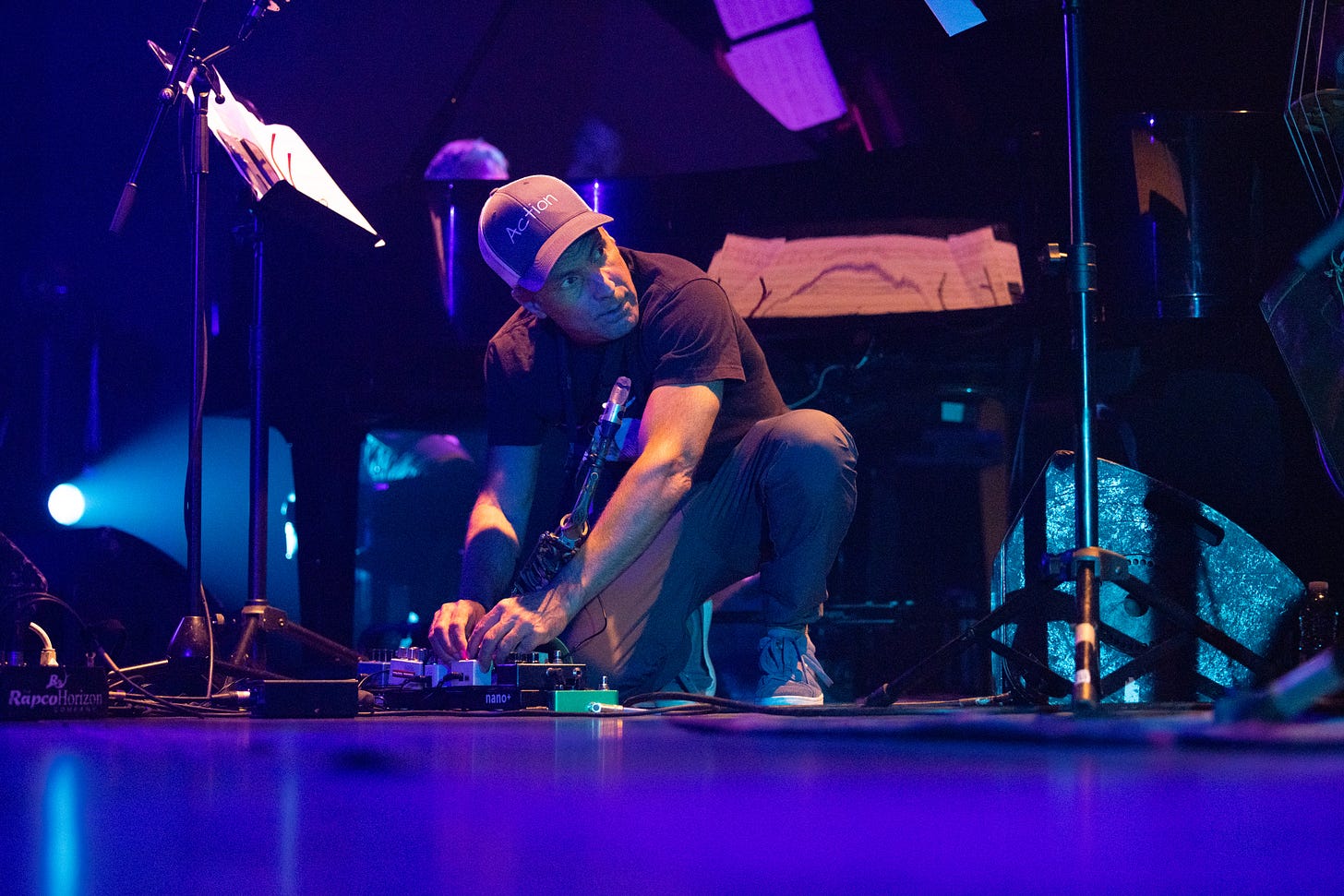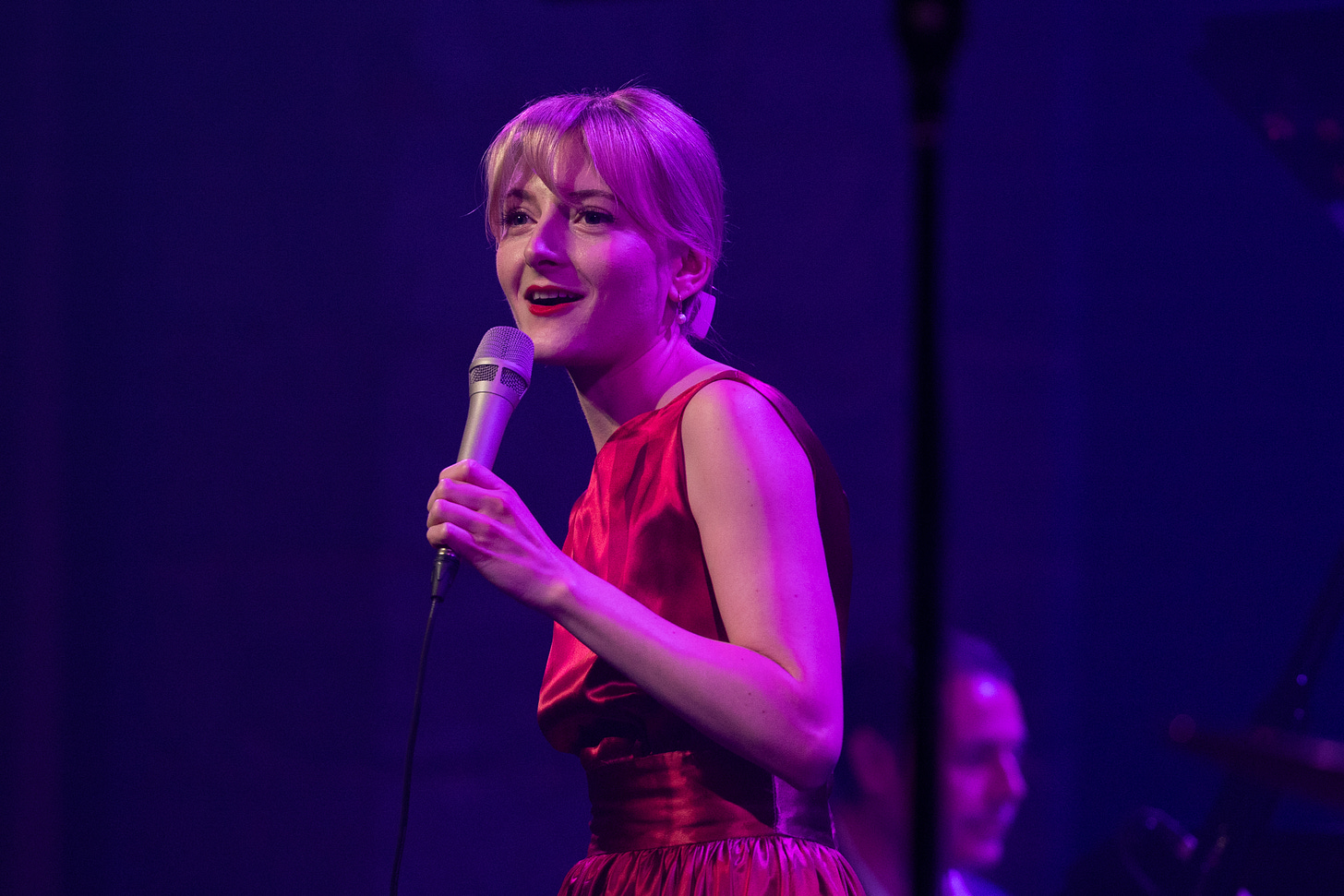I cut short my visit to this year’s Festival International de Jazz de Montréal, for reasons I needn’t bore you with here. But I came away with good photos from two concerts, plus some stories about music. Such things are better shared. So here’s what I saw and heard.
As I did for last year’s festival, I worked with a wonderful photographer to show you what musicians look like at work. Nasuna Stuart-Ulin has been working frequently for the New York Times; she was covering British Columbia wildfires for them (trust me, that’s a link worth clicking) when I called her about working on this year’s festival.
My festival this year began a night early, with the Jazz at Lincoln Center Orchestra under the direction of the legendary trumpeter Wynton Marsalis. The JLCO was touring, as it often is, and the only night that worked for Montreal was the night before the festival’s official start. The venue was the Maison symphonique, a wonderful room for acoustic music but, as it turned out, one that puts up a fight when somebody tries to amplify the proceedings.
Jazz at Lincoln Center began 37 years ago as a series of summer concerts, when Marsalis was 26 and had already won seven of his nine Grammy awards to date. It soon became a permanent constituent department at Lincoln Center. Marsalis talked then-Mayor Rudy Giuliani into city funding for a permanent home for JALC on Columbus Circle. The organization runs an ambitious annual competition for high-school bands, Essentially Ellington, that has helped launch hundreds of musical careers.
Marsalis is an institution, in other words. He used to be more controversial. People worried, and he often seemed to hope, that more of his kind of jazz would mean less of other kinds. It’s clearer now that most musicians’ biggest problem isn’t other musicians. Marsalis in turn has mellowed. At the Maison symphonique, he acted as a section trumpeter and congenial host, never budging from his chair at the back of the horn section. He played only two trumpet solos all night. I’ve never heard less Marsalis at a Marsalis concert, and rarely enjoyed a concert by this big band more.
The JLCO is a superb ensemble. Thousands of nights playing jazz classics and challenging new compositions have honed its members’ sense of themselves and their colleagues. Their Montreal program started with three pieces originally written as commentary on American racial politics, Marsalis’ own “Black Codes,” Charles Mingus’ “Fables of Faubus” and John Coltrane’s “Alabama.” A comment on current events? Hard to tell for sure, especially because the boomy room defeated trombonists Chris Crenshaw and Vince Gardner in their delivery of Mingus’ barbed lyrics.
But any thematic unity to the night ended after the three openers. The rest of the program was an agreeably mixed bag, featuring suave ensemble playing and a succession of powerful solo turns, from everybody in general and trumpeters Ryan Kisor and Marcus Printup, saxophonist Abdias Armenteros, and drummer Obed Calvaire in particular. The band seemed taken aback by the warmth of the standing ovation at the end. Montreal audiences are reliably demonstrative. As we shall see.
Caity Gyorgy sang on the festival’s for-real opening night at the Gèsu, a gorgeous 425-seat converted chapel. It was her first festival concert in the city where she lives and went to university. It will surely not be her last, which means that next time, the disembodied offstage voice that introduces each act will get a chance to pronounce her name correctly. It’s pronounced “George,” as readers of this Substack are sometimes reminded. This is becoming useful information, especially at Juno Awards time.
At 27, she’s a charming singer whose often understated delivery belies serious study of harmony, ensemble dynamics and the example of her elders. Her originals sound like standards; her delivery keeps standards fresh. She’s developed a valuable rapport with the formidable Calgary pianist Mark Limacher; their duet album, from April, will compete with her album of originals backed by Limacher’s orchestral arrangements, coming in August, for next year’s Junos.
On Instagram the day before the concert, she invited followers to send in requests. I sent in one for “I Believe In You,” from the April duet album of Mark Loesser tunes, because I know how she likes to finish it: by building in volume and tension over the last half-chorus in a bravura display few singers anywhere can match. She didn’t disappoint.
Gyorgy sings in Ottawa tonight and in Banff in two weeks. Tickets are still available. This will not always be the case.
It was mostly a hazard of the festival’s early programming that made my concert choices this year hew so closely to the jazz mainstream. The festival is, of course, so big that a thousand other paths through its mazes are possible. Blue Rodeo played a free outdoor concert. The Mexican singer-songwriter Natalia Lafourcade filled a big hall for an intimate set, performed on acoustic guitar from a chair next to a side table with a bottle of mezcal on it. "¡Que viva México!", a guy in the audience shouted just before Lafourcade came onstage. (Here’s a review of her Boston show a few nights later.)
There is also still room for more unruly jazz. I was surprised to see David Binney’s name when I made a last-minute check of the festival’s opening-night schedule. I’m wired to notice names like Binney’s, but he didn’t appear in earlier drafts. Turns out the gig came together only days before the festival began.
Binney is an alto saxophonist from Los Angeles. I’m amazed to see he’ll turn 64 this year, but I suppose that’s fair, because he’s been an important player, however these things are measured in contemporary music, since the early 1990s. Increasingly he’s a hub and patriarch to a Los Angeles jazz scene that’s almost unrecognizably more quirky and adventurous than it was when most musicians in that city were earning most of their money in recording studios. (Here’s Nate Chinen on today’s LA scene.)
He played the opening-night 10 pm show at Studio TD, an unfussy venue for amplified music that opened in 2009 and fits 650 if nobody needs to breathe. It’s not even a quarter the size of the fabled Spectrum, the home to legendary performances by The Police, Miles Davis, Jean Leloup and hundreds of others that used to sit across the street that Studio TD effectively replaced. But Studio TD is still big enough that events there benefit from a sense of occasion as well as intimacy.
Under Laurent Saulnier, the FIJM’s former artistic director, Studio TD often hosted free concerts by artists who could easily have sold the place out if tickets were required. Saulnier just liked a room full of rowdy fans and didn’t think artists should aways have to worry whether they’d sell their quota of tickets. His happy example has been followed by the festival organizers who succeeded him.
But Binney isn’t a big name and his appearance was a last-minute thing, so when he took to the stage the big room was nearly empty. At first I felt disappointed on Binney’s behalf.
He told the hardy little crowd that Montreal has been a second home to him for much of his life. He was playing with three musicians who come from elsewhere, have often played at the highest levels elsewhere, and now call Montreal home: bassist Walter Stinson, drummer Tommy Crane, and especially the French pianist Jean-Michel Pilc, who was hired by McGill a decade ago and who has been drawing musicians who are willing to get to Montreal just to play with him.
“We’re mostly just going to improvise,” Binney said by way of introduction. “It’s a jazz festival, but nobody really improvises anymore.” “Nobody” is an exaggeration, but it would be accurate to say few bands improvise as much, based on as little prepared material, as Binney and crew did here. The tunes were often just a two-bar bass vamp, or a scrap of melody designed to cue other musicians to the intentions of whoever was taking the lead at any given moment.
Binney likes to weave electronics into a band’s sound, sometimes elaborate schemes from a laptop computer, sometimes echoes and delays from guitar pedals. Watching him from the back of a room can be disconcerting because he sometimes vanishes beneath the sea of heads. At those moments, he can usually be found crouching over his pedal effects, twisting knobs to control the weird sounds.
At one point he rose from his crouch to deliver a relatively orthodox, and entirely persuasive, performance of “Portrait of Jennie,” the theme song to a 1948 movie that’s become a jazz standard. Binney studied with jazz elders like Phil Woods and George Coleman a lifetime ago, and while he rarely hangs out in those neighbourhoods any more, he clearly doesn’t mind a return visit. Pilc, Stinson and Crane were just as ready to switch gears.
But it was the less familiar music, the shifting, rhythmically tricky, harmonically contingent stuff the quartet built from scraps of almost nothing, that dominated the night. At one point, a ferocious alto-sax solo from Binney drew a roar of approval from the audience. Which is when I realize the audience had grown big enough to roar.
I’ve seen music like this drive the timid from all kinds of rooms over the years. But this festival has a knack for drawing Montrealers who are made of sterner stuff. Over the first 40 minutes of the Binney set, more people showed up curious than the number who left confused. Pretty soon the room was packed.
Musicians who believe in what they’re doing play with a certain sound that, to some extent, transcends genre. Montreal audiences aren’t unique in responding to that sound, but they’re lucky to have had more exposure to it than audiences in a lot of other places. Word gets out.
When the room was empty, I had shared a few mournful words with Nasuna Stuart-Ulin, the photographer. Now that it was full, I sent her a text: “OK it got better.”
“Hah yup,” she wrote back. “Montreal style.”











Paul, I subscribed to you for your insights on public policy, but find I look forward to you excursions deep into music. A delightful read!
Wonderful report, Paul, much appreciated even though I'm not into jazz!